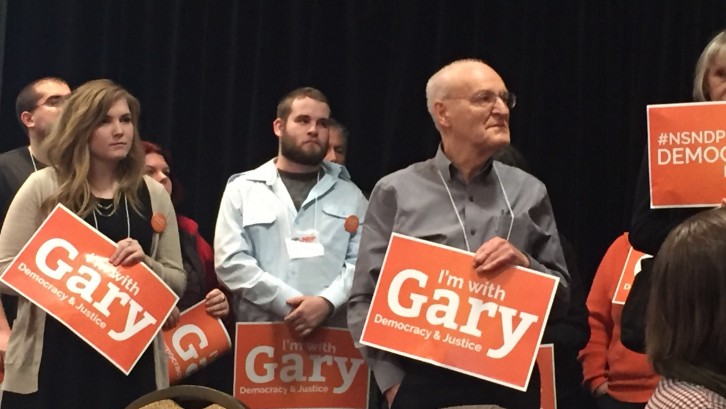Politics
Nova Scotia NDP breaks record with electronic voting
Gary Burrill wins leadership with 74.2 per cent turnout

caption
Voters of all ages turned out online or by phone.
caption
Gary Burrill, centre, strategizes minutes before announcement he will be N.S. NDP party leader.Gary Burrill was elected new leader of Nova Scotia’s New Democratic Party on Saturday. Around 2,700 people turned out to vote – and not one of them pencilled in a ballot.
For its first leadership election in 15 years, the NDP introduced a new electronic system that allowed members to vote online or by phone to rank each of the three candidates.
“It is the 21st century,” said provincial secretary Mike Poworoznyk. “We wanted to make sure that we had it accessible to people.” Related stories
He says the party is looking to engage less-mobile voters and members across the province who may have a difficult time getting to Halifax.
Burrill, an ordained church minister, won on a second ballot with 59 per cent of the vote. He defeated Lenore Zann and Dave Wilson, who are both sitting members of the legislature.
Intelivote Systems, an electronic voting company based in Dartmouth, said that the provincial party had the highest turnout of the 10 leadership elections it has facilitated.
Around 75 per cent of party membership voted in Nova Scotia’s NDP election, beating out participation for British Columbia’s NDP leadership race in 2011.
It was the first time the party had used the online and phone voting system, an upgrade from the mail-in ballots used in previous years.
“You can vote from any device, really anywhere in the world,” said Intelivote president Dean Smith. “You can use a smartphone, you can use a tablet … you can use an Xbox, if you like.”
Before voting, party members received a personal identification number in the mail. They were also asked to provide their date of birth to ensure that they had registered.
Voters were then asked to rank each of the candidates according to their preferences, then prompted to confirm their correct choice. Ballots were also encrypted to protect the privacy of voters.
According to the party, only two of 2,269 ballots were spoiled.
Older voters favour phone
The candidates’ campaigns oversaw the process, assisting with the party’s helpline which was open from Feb. 15 until voting closed at 2:30 p.m. on Saturday.
Jim Morton, Gary Burrill’s campaign manager, said some members had difficulty logging onto the website, but he thinks it was an issue of following instructions more than anything.
Some members may not be used to this kind of voting system.
“If anybody’s having some difficulty with it, we’ve found – I hate to say it – it’s people of my generation. It’s people with grey hair,” said Dennis Theman, a party executive on the voting working group.
According to Smith, president of Intelivote, roughly 60 per cent of voters over the age of 60 cast their ballot online, compared to around 90 per cent of voters between the ages of 18-40.
Older voters are an important cohort in many elections, turning out at high rates. According to Elections Canada, 75.1 per cent of people between the ages of 65-74 voted in the 2011 federal election.

caption
People of all ages voted online or by phone.An all-ages party
The NDP is rebuilding after its defeat in 2013.
It has been working to engage younger voters, even hosting a panel at the convention to showcase fresh faces within the party.
“We’re seeing all ages, and I think it’s probably because people want to see something different,” said Poworoznyk, the party’s provincial secretary. “I think the world gets a little bit smaller, but I think there’s no misplacing the value we put on face-to-face.”
